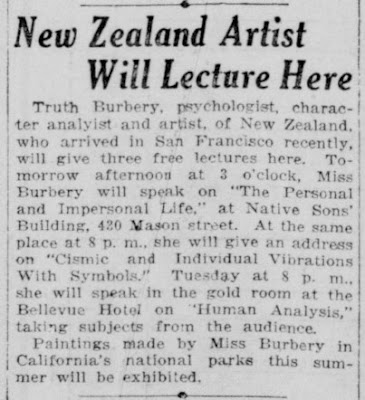 |
| Ad from the Los Angeles Evening Express, Oct. 3, 1925 |
According to the Santa Ana Register, on March 25, 1925 Yogananda was “acting as chauffeur to one of his followers, Mrs. Truth Burbery,” and crashed into and wrecked the car of farm worker and teamster William C. Showalter at 17th St. (now Westminster Ave.) and Bolsa Rd. (now Brookhurst), in Garden Grove. Showalter’s wife, Josephine, was injured. (“Court Notes,” Register, May 20, 1925, page 3.) The Showalters sued for $3,000.
So, what do we know about the less-famous people involved in the car wreck?
William Showalter (1871-1966) was a typical Orange Countian of his day – a transplant from the Midwest (Ohio), who found work in the local agricultural economy. Since arriving, he’d been a farmer, a laborer, and as a teamster for a tomato seed company. He and his wife, Josephine Lottie (Rickel) Showalter had at least nine children. Nothing surprising for a rural family.
 |
| Approximate site of the accident, as seen today. |
Truth Burbery, by contrast, was full of surprises. She was born Gertrud Clara Boehmer in Memel, Germany on Sept 23, 1877. A high school graduate with no college, she still cut quite a path for herself.
In 1903 she married Sergeant Major James Burbery, a gunnery instructor, in Heathcote Valley, New Zealand. Somewhere along the line, she adopted the name Truth, which one must admit is catchier than Gertrud. James died in Wellington, New Zealand two days before Christmas 1915.
Truth arrived in the U.S. on March 23, 1917, coming to California by way of Sydney, Australia and then Hawaii aboard the vessels Tahiti and Sonoma. She identified her occupation on the ship manifest as "Secretary of a Religious Movement".
In the 1910s and ‘20s, Burbery taught "the psychology of your name and birth date, love, marriage and divorce. Life's master positions." She spent 1918 and 1919 in North Carolina, where her ads in Asheville newspapers read, "Mothers, help your children into their right vocations in life. Learn the ancient science of numerology. Complete system can be learned in six lessons. Interviews daily. 29 Vance Street."
 |
| Ad from the San Francisco Examiner, Nov. 6, 1921 |
But she spent much of the 1920s in California, putting on programs as a “psychologist” specializing in "personal and impersonal life: cosmic and individual vibrations." She also began to be known as a bohemian artist, creating paintings and illustrations.
In 1924, she published a book, Hindu Dietetics for Body Building: Including the Nervous and Glandular Systems.
She dedicated this book to a "teacher" (identified only as S.C.) who translated the recipes from Bengali and "so made it possible for the Western world to benefit by a clean wholesome, pure and nourishing diet".
The book also calls out the specific benefits of many foods. Orange Countians will no doubt be glad to know, for instance, that oranges are “good for the voice; to correct asthma and shortness of breath. The juice increases bodily temperature. The bitter skin decreases fever. The dried skin of oranges chewed the first thing in the morning will act on the salivary glands, inducing new flow of healthy saliva... Orange seeds are useful in cases of piles or vomiting."
 |
| Blurb from the San Francisco Call, Nov. 5, 1921 |
In 1925 – the same year as car wreck – Burbery contributed an illustration of New Zealand’s Dusky Sound to the very first issue of East West Magazine, published by Yogananda in Los Angeles.
Burbery settled into a new home in San Francisco in Oct. 1925. Aside from a year spent away in 1927, she spent much of the rest of her life in San Francisco. She was naturalized there on Groundhog Day, 1931, and finally had her name legally changed to Truth Burbery. Among other things, she taught art and worked as a nurse.
Another disciple of Yogananda, Sri Durga Mata (the former Florina Dufour), mentioned in her autobiography an instance of the guru having lunch with Burbery while on a trip to San Francisco in late 1936. Burbery was also still attending Self-Realization Fellowship events through at least 1937.
From perhaps the late 1930s until the time she died of cancer on May 2, 1942, Burbery was employed by the WPA Arts and Crafts Project in San Francisco. Her memorial was led not by a maharishi or guru, but -- curiously enough -- by a Rosicrucian mystic.
In any case, it all goes to show that you never know who you'll run into in streets of Garden Grove.





















